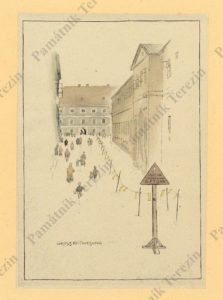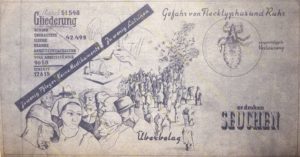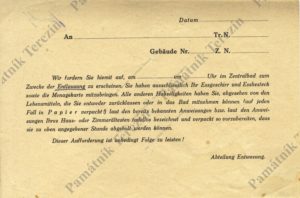
Jo Spier: Disinfection (disinsectization) of the buildings, Terezín, 1943 – 1945; oficial production, Terezin Memorial, PT 4343, © Peter E. Spier, Dr. Thomas Spier, Celine Spier Polak
The Terezín ghetto was to serve merely as a stop for Jewish prisoners before their final liquidation in the East as planned by the Nazis. Yet, even this “stop” created conditions which contributed to the deaths of thousands of deportees. From the beginning, there were problems associated with the location and survival of huge amount of people, their nutrition and especially hygiene being more than insufficient. The ghetto inmates suffered from lice, fleas, flies, bedbugs. It was not until later that, thanks to the efforts of the prisoners themselves, people were partially deprived of parasites for some time.
Upon entering the ghetto newcomers became terrified of dirt and devastation left behind by the Wehrmacht soldiers after having cleared the barracks. The barracks served as the first home to the Terezín prisoners, whose placement into civilian blocks started as late as in mid-1942. Quarters were gradually furnished with three-storey bunks and became, considering the huge numbers of newcomers, constantly overcrowded – in December 1941 there were 7,350 prisoners, in June 1942 their number climbed to already 21,269 and in September 1942 it amounted to 60,000. People slept crammed together on narrow beds, which created ideal conditions for the spread of diseases and insects.

Petr Kien: Illustration to the report on the state of health, Terezín, 1942; oficial production, Terezin Memorial, PT 10128
Efforts to maintain cleanliness and prevent the spread of the epidemic were evident from the outset. Jewish autonomy did everything to help the inmates. The Department of Disinfection, created within the health care, gradually grew to as many as 300 workers engaging also the leaders of quarters and houses, who were obliged to monitor adherence to necessary measures adopted in order to conserve water and to maintain cleanliness. Already in the first weeks of the ghetto existence, a station for combating insects was founded in the Hohenelbe Barracks.
Major problems with lice occurred mainly in the summer of 1942, when transports with mostly elderly prisoners from Germany and Austria started getting in. After several days of journey, people arrived sick, dirty and full of lice (a record on an Austrian transport of 21st June 1942 says that the whole thousand of people on were heavily lice-infested). This fact naturally endangered the other inmates.
Disinfection and Delousing
To find a way out of the situation was rather complicated. The capacity of the old shower baths in the Hohenelbe Barracks was insufficient for successful delousing. In a closed and crowded city it was impossible to separate the clean from the unclean. Deloused people constantly encountered with the lice-infested at work, at the barracks, in queues for food rations, etc. The winter of 1942/1943 was in this regard very cruel: the delousing process was interrupted several times, once for the lack of personnel as the result of transports to the East, another time for the lack of excipients…
An inspection of the newcomers to the ghetto was indispensable for the success of the delousing process. Those Infectiously ill were sent to isolation rooms in the hospital, those with lice to a delousing station. On 1st May 1943 shower baths in an old brewery were put into service , which made the delousing process more efficient.
The fight against insects involved further important activities such as inspections of homes, workplaces and other places. They should be repeated at certain intervals. However, conditions in the places where investigations were conducted were very poor. The rooms were dark, overfilled with two- and three-storey beds; every little place was stuffed with clothing, bedding, suitcases, boxes and the like. Often there were no sockets for doctors’ lights, moreover, there was a general lack of lights. Old people were hiding warm clothes, hernial belts, etc. in fear of losing them during the inspection. The unclean fled or hid so that their condition was not disclosed.
Besides people, disinsectization covered also clothing, luggage and bed linen. It was done by means of vapour, sulphur dioxide, Ventox (clear water-like liquid supplied in cans), and from February 1943 also with the use of Cyclone, a hydrogen cyanide supplied to the ghetto from Kolín (town in the Protectorate of Bohemia and Moravia). Some things were disinsectizated while kept in suitcases and boxes.
In case of lice infestation of quarters, the whole rooms with all the luggage, clothing, beds, etc. were gassed. That way things did not have to be moved to delousing stations. So-called “cleaning service” was responsible for proper cleaning of all rooms, which involved washing the wooden bunks and inserts thoroughly with Lysol water. Gassing was done with the use of the aforementioned chemical means. Although residents were given guidance on how to air a gassed quarter and when to move back, a few people even died as a result of staying in an insufficiently aired room after delousing.

Jo Spier: Caricature of the king of the infection diseases, Terezin, 4. 2. 1944; Terezin Memorial, PT 5212, © Peter E. Spier, Dr. Thomas Spier, Celine Spier Polak
Intrusive insects posed a problem around the ghetto in all age groups. Articles about catching fleas and other vermin appeared in youth and children’s magazines as well, e.g. the children’s magazine Domov (Home) published an article under the headline “A New Kind of Sport” dealing with the endless nocturnal struggle of a man with the flea superiority.
The section Rambles through Terezín in the magazine Vedem describes the operation of a Delousing Station. Fleas, lice and difficulties associated with them became a popular inspiration for the Terezín black humour. With time most of the prisoners became extremely skilful in catching fleas and learned to end their lives between the nails of two fingers. Wives and girlfriends went to the quarters of their men to help them catch fleas on the bunks. There was a custom and necessity to air the blankets and pillows in quarters in the morning in an effort to banish intrusive insects.
The satisfactory situation in 1944 was soon terminated with an influx of evacuation transports to the ghetto in April 1945. People in these transports were hardly recognizable, skinny, sick, filthy, many without shoes, constantly endangered by their tormentors. These people brought lice again into the camp and, in addition, the typhoid epidemic too. The SS made it impossible to carry out the necessary measures to establish quarantine blocks, therefore the lice-infested and deadly ill newcomers often mingled with the original Terezín prisoners. Very soon a new epidemic flared up in the area of Terezín, spread by intrusive insects, the typhus.
————————-
Source:
Terezín očima hygienika (Terezín Viewed by a Hygienist), memoir of J. Pacovský No. 760.
Bondy Ruth: Life with Insects, in: TSD 2005, p.151 – 161
Chl, Se



